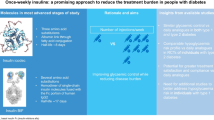Summary
Comparisons were made in 24 (study 1) and 10 (study 2) patients with non-insulin-dependent diabetes mellitus (NIDDM) concerning the single dose effects of glipizide given (a) as a rapid-release soft gelatin capsule containing the drug in solution, (b) in conventional tablet, and (c) intravenously. The oral formulations were administered 30 minutes before and the intravenous formulation immediately before standardised breakfasts. The glipizide doses were capsule and tablet 5mg (study 1) and capsule, tablet and IV 2.5mg (study 2). Glipizide levels were measured by liquid chromatography; insulin, proinsulin and C-peptide levels by radioimmunoassay; and blood or plasma glucose levels by a glucose oxidase method. Glipizide absorption was faster from the capsule. Intravenous (2.5mg), capsule and tablet (2.5 and 5mg) administration of glipizide augmented the post-breakfast increase in insulin and C-peptide levels and reduced the post-breakfast hyperglycaemia. Both capsule and tablet (5mg) [study 1] augmented the post-breakfast increase in proinsulin levels, in proportion to those of insulin. Despite the more rapid absorption of glipizide from the capsule compared with the tablet, and despite the immediate rise in glipizide levels following IV administration, there was little difference in serum insulin levels between formulations, and no difference in blood or plasma glucose levels. This contrasts with previous findings in healthy volunteers and in subjects with newly detected NIDDM. The insulin responses in the patients of study 2, who ingested 600 kcal, were more pronounced than in those of study 1, in which patients ingested only 378 kcal, even though the latter had glipizide levels that were 3 times higher. This supports the notion that an increase in sulphonylurea dose cannot compensate for increased energy intake. The net effect of 5mg glipizide on proinsulin levels seemed limited to about 4 to 6 hours, suggesting that this dose would not cause chronic hyperproinsulinaemia.
Similar content being viewed by others
References
Bitzén P-O, Melander A, Scherstén B, Svensson M, Wåhlin-Boll E. Long-term effects of glipizide on insulin secretion and blood glucose control in patients with non-insulin-dependent diabetes mellitus. European Journal of Clinical Pharmacology 42: 77–83, 1992
Bitzén P-O, Melander A, Scherstén B, Wåhlin-Boll E. The influence of glipizide on early insulin release and glucose disposal before and after dietary regulation in diabetic patients with different degrees of hyperglycemia. European Journal of Clinical Pharmacology 35: 31–37, 1988
Faber OK, Markussen J, Naithani VK, Binder C. Systematic production of antisera to synthetic benzyloxycarbonyl C-peptide in human proinsulin. Hoppe-Seyler’s Zeitschrift für Physiologische Chemie 357: 751–752, 1976
Groop LC, Barzilai N, Ratheiser K, Luzi L, Melander A, et al. Dose-dependent effect of glibenclamide in insulin secretion and glucose uptake in man. Diabetes Care 14: 724–727, 1991a
Groop LC, Ratheiser K, Luzi L, Melander A, Simonson DC, et al. Effect of glipizide on glucose-stimulated insulin secretion in healthy and non-insulin-dependent diabetic subjects. A dose-response study. Acta Diabetologica 28: 162–168, 1991b
Hartling SG, Dinesen B, Kappelgård M, Faber OK, Bincer C. Elisa for human proinsulin. Clinica Chimica Acta 156: 289–298, 1986
Hartling SG, Faber OK, Wegmann ML, Wåhlin-Boll E, Melander A. Interaction of ethanol and glipizide in humans. Diabetes Care 10: 683–686, 1987
Heding LG. Determination of total serum insulin (IRI) in insulin-treated diabetic patients. Diabetologia 8: 260–266, 1972
Helqvist S, Hartling SG, Faber OK, Launchbury P, Wåhlin-Boll E, et al. Pharmacokinetics and effects of glipizide in-healthy volunteers. A comparison between conventional tablets and a rapid-release soft gelatin capsule. Drug Investigation 3: 69–75, 1991
Melander A, Bitzén P-O, Faber O, Groop L. Sulphonylurea antidiabetic drugs: an update of their clinical pharmacology and rational therapeutic use. Drugs 37: 58–72, 1989
Stenman S, Melander A, Groop PH, Groop L. What is the benefit of increasing the sulfonylurea dose? Annals of Internal Medicine, in press, 1993
Temple RC, Carrington CA, Luzio SD, Owens DR, Schneider AE, et al. Highly specific insulin assay reveals uniform insulin deficiency in non-insulin-dependent diabetics. Lancet 1: 293–295, 1989
Wåhlin-Boll E, Melander A, Sartor G, Scherstén B. Influence of food intake on the absorption and effect of glipizide in diabetics and in healthy subjects. European Journal of Clinical Pharmacology 18: 279–283, 1980
Wåhlin-Boll E, Sartor G, Melander A, Scherstén B. Impaired effect of sulfonylurea following increased dosage. European Journal of Clinical Pharmacology 22: 21–25, 1982
Author information
Authors and Affiliations
Rights and permissions
About this article
Cite this article
Haaber, A.B., Groop, PH., Bitzén, PO. et al. Pharmacokinetics and Effects of Different Formulations of Glipizide in Patients with Non-Insulin-Dependent Diabetes Mellitus. Drug Invest. 5, 114–120 (1993). https://doi.org/10.1007/BF03259582
Published:
Issue Date:
DOI: https://doi.org/10.1007/BF03259582




